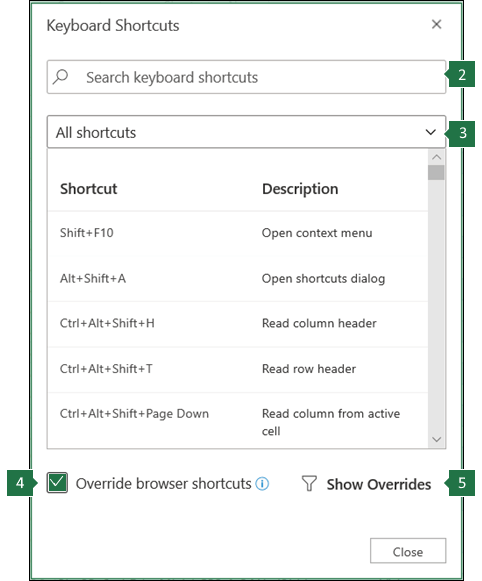

If your desired cell isn’t visible in the excel spreadsheet window, you can use the scrollbars to scroll the window in any direction to reach your desired cell.
/ExcelCharts-5bd09965c9e77c0051a6d8d1.jpg)
If you want to change the active cell by using your mouse, just click another cell, and it becomes now the active cell. *With Scroll Lock-on Navigating Excel worksheet with mouse Scrolls the screen right one column (active cell position is not changed) Scrolls the screen left one column (active cell position is not changed) Scrolls the screen down one row (active cell position is not changed) Scrolls the screen up by one row (active cell position is not changed) Scrolls the screen so that the active cell is visible Moves the active cell right by one screen Moves the active cell one column to the right Moves the active cell one column to the left
EXCEL KEYBOARD SHORTCUTS 2013 EDITING FULL
Pg Up and Pg Dn move the active cell up or down one full window. The down arrow key moves the active cell down one row, the up arrow key moves the active cell one row, the right arrow moves the active cell one column to the right, and so on. We shall use the standard navigational keys on our keyboard to move around a worksheet. Moving around the Excel Spreadsheet with your keyboard Row and column headings of the active cell appear in a different color to make it easier to identify the row and column of the active cell.

If there were something in the active cell, it will be deleted if you enter something this way. If you have opened an existing spreadsheet, the active cell will be the last cell you selected before saving and closing the spreadsheet.Īctive cell means that it is active now if you enter something from your keyboard, it will accept. If you have created the spreadsheet just now, active cell will be A1 by default. When you open an Excel spreadsheet, you will find one cell is selected with darker borders. Commands to find the last cellįind the last row with this command: End →Down Arrow(↓), then find the last column with this command: End →Right Arrow(→), you will reach the last cell. The address of the last cell is XFD1048576.

To delete a character to the right, use Delete in Windows, and function + delete on a Mac.įinally, to add a new line in a cell, use Alt + Enter in Windows, and Control + Option + Return on a Mac.Highlighted Last Cell in an Excel Spreadsheet. To delete a character to the left, use backspace in Windows, and the Delete key on a mac. To move through text one character at a time, use only the right and left arrow keys.īy adding shift, you can precisely select one or more characters. To step through a cell word by word, use the control key with the right or left arrow keys.Īs before, you can combine this with the shift key to select individual words and references. You can combine these shortcuts with shift to select everything in the cell from either direction: To move to the end again, use the End key in Windows, and function + right arrow on a mac. To move the cursor to the beginning of the cell, use the Home key on Windows, and function + left arrow on a mac. When first enter edit mode, you're cursor will sit just after the last character in the cell. You can also use the Undo command when editing a cell. However, pressing F2 (or Control U on a Mac) takes me directly to the formula bar.įor the rest of this video, I'll leave that setting, since the shortcuts we're going to look at will be easier to see in the formula bar.Īt any time you've started editing a cell, you can cancel the edit by clicking the Escape key. With this change, I can no longer double-click to edit a cell. On a Mac, go to preferences by using Command + comma, then click "Edit", and uncheck checkbox called "Double clicking allows editing directly in a cell" Then go to Advanced, and uncheck the checkbox labeled "Allow editing directly in cells" In Windows, use Alt F to access the File menu, then T to access options. If you want to always edit cells in the formula bar, even when you use a keyboard shortcut to edit a cell, you'll need to change a setting. You can also double-click a cell to edit. With Excel's default settings, this will put your cursor directly in the cell, ready to edit. In this video, we'll look at shortcuts for editing cells.įirst, the keyboard shortcut for editing a cell is F2 on Windows, and Control + U on a Mac.


 0 kommentar(er)
0 kommentar(er)
